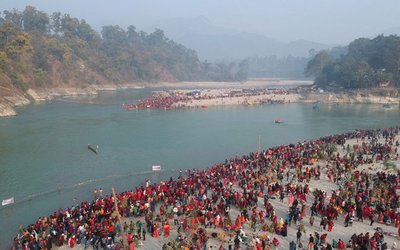
Mountains should be admired because they are there, yes, but more so because they present an arena with indefinite limits in which to play out our delusions of human grandeur. For those who see themselves as heros/heroines, there is the challenge of the unknown – the fields of permanent snow that may or may not hide a crevasse or come tumbling down as an avalanche, spraying the atmosphere with a kaleidoscope of colours and leaving behind the aching and limitless silence of death. Indefinite space, mountains can be a gateway to the indefinite space of eternity.
There are logical, scientific reasons to admire mountains. Geologists are usually entranced by the idea that the rocks tell a story going back into the limitless reaches of time. And in the areas that the snow doesn’t cover all year long, you can find the lichen, the great survivor through eternity: if only it could speak!
Once on the top of a mountain you have the heavens above you and around you – the world spread out below. The rippling vistas, ridge upon ridge stretched to the very edge of the earth. The very highest mountains give the added edge of hypoxia and perhaps hallucination. Is that why the great sages believed that eternity was to be found on the roof of the world, as they looked across the sky and through the fields of stars? They weren’t to know that each star could have been quite unsparkling at close quarters. For them it was a never-ending ocean of light. For lesser mortals, there was always the belief that long-lost creatures stalked the heights, and hence came the yetis and big foots of the mountain world.
These creatures bridge the gap between the divine and the human in the mountains. They bring us down to earth, into our own space, because the particular type of creature seen or unseen depends upon the mountain region you come from–it defines you. The yeti stalks the Himalayas and Hindu Kush and ‘big foot’ the Appalachians.
All this comes from a deep human belief that mountains are not quite what they seem. They’re a mystery. Those parts of mountains that are still clothed with virgin forest seem to have eyes that look at you when viewed from afar. Inside the forest, it is easy to believe that there are caves somewhere that will take you down into the belly of the earth. Flora and fauna we don’t even know of, parts of planet earth we have never seen. Because of course, we believe mountains come from the earth’s belly. The collision of the continents and the pounding of the frontiers of the ocean floor thrust these giants up into the sky, section by section, creating fault after fault and, in consequence, the possibility of future upheaval. One day of course, whether we witness it or not, it could all be quite settled, a honed down the range of mountains, and the earth’s geomorphological perspective might be quite different to what we see today.
Beyond these, the mountains of myth and legend, are the mountains of the worker. These present quite a different picture from that of the mountains of the sage and the climber, the mere adventurers into the territory of the spirit or the territory of human endeavour. These are the mountain people who are limited to their terraced fields of maize or buckwheat and hardier vegetables and villages with defined boundaries, defined by tradition or superstition and watched over by spirits both friendly and unfriendly, the whisperers hidden in caves who need to be placated so that you can bring the harvest home and survive the winter.
From their perspective, the mountains have well-defined patterns; the patterns that define my fields, your fields – the boundaries of stupendous successions of bunded terraces containing their lives, their lifestyles, their next season’s meals and community occasions.
Such defined boundaries are sacred, sacred because of the food they produce and because of the very sanctity of the soil that nurtures the mountain dweller. Their products are used to survive and to offer to the gods in worship, rituals that go back in time to the era of cave paintings and animism because they seem to have worked, because they bring out the fruits of the earth from the harsh mountain soils year after year, century after century—will it last?
Other defined boundaries, of course, are not so sacred. They contain a lake or a view, a famous mountain—there are famous mountains which, in their own right, have just as big a pull as film stars. To have actually climbed one of them is almost as good as getting a famous autograph or rubbing shoulders in a crowd milling around the celebrated. These are the mountain areas for tourists, the areas that provide one with a place within a mountain area in which city dwellers can be in the mountains with almost the comforts of home-roughing it without actually having to meet the exactitudes of the normal mountain dweller who negotiates survival on a daily basis in the most difficult areas of the earth. The tourist can always go home. The tourist treads latitudes and longitudes for pleasure, discarding them and leaving them behind at will.
When mountains occur on the earth, they usually do so in quantity. They are a range. Sometimes they have a hoard of treasures. In such cases, the human animal with its exploitative industry will rip out the goodies in enormous quantities-until they have exhausted the very womb of the earth. They then trade the riches it has taken millennia to form for the essentials--for plastic trash and the expendable paraphernalia of ‘modern’ life–usually on unequal terms of exchange.
Thus the riches of the mountains reach the cities, the jewel captured in the rock that tells a story will end up in a shop window. There are those who believe the shop window sets them off beautifully, because they’ve never seen the jewel’s original environment of ice and rock against a necklace of stars, or felt the awesome power that forged it all out of the earth, thrusting upwards against time.
Thrusting upwards, unseen, unless the earthquakes and the glacial lakes burst the ends of their moraine dams and come down, ‘asha asha’ all falling down, collapsing in the thunder that drowns even the sounds of the perpetual mountain winds. For the mountains will grow until nature dictates that they will stop thrusting upwards and the winds and elements pound them into a plateau. Only then do mountains cease their relentless vertical endeavour and begin to enjoy the birds and animals from a lost horizon. They settle and we perch — humans who will never rest until the last refuges on earth are filled with their clutter. Until then, mountains are the last refuges of sanity. The places into which one can escape, knowing it’s hard to follow.
** First published by Steve Pile of the Open University, UK
Post Scriptum
I sought permission to use this article, originally written at Dr.Pile’s request, as part of a publication on places. I used it this Summer of 2017 as a background piece to various aspects of life in a mountain land. Now I am using it again as an introduction to the many trekkers and mountaineers who come in the Autumn, some appreciative of what the mountains offer them and some who, after a swift sigh of pleasure, leave their used and no longer needed kit to decorate the mountain slopes. We are grateful that our mountain people can enjoy a better standard of living because of these visitors, but feel the need to try and describe the mountains as we see and feel them, we who live a little closer to the ‘daughters of heaven’, to those who just pass by.
- Hostage – A brief Review
- May 23, 2019
- Exodus 1 - From The Rhondda To The Calder
- Feb 09, 2019
- Exodus 1 - From The Rhondda To The Calder (Mid-1800s)
- Dec 08, 2018
- Why: A Look At Certain Strange Characteristics!
- Nov 02, 2018
- Where To Now?
- Oct 12, 2018

















